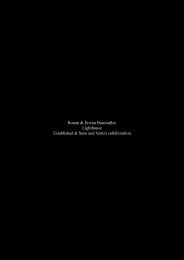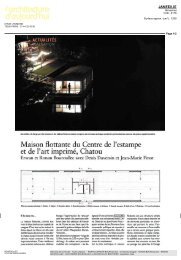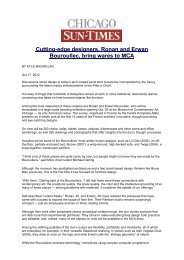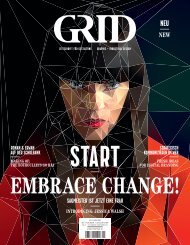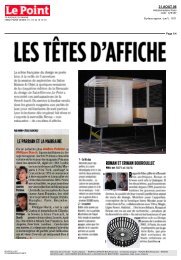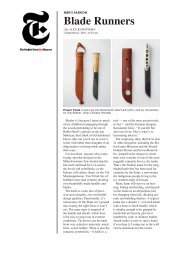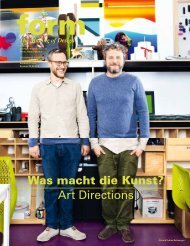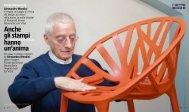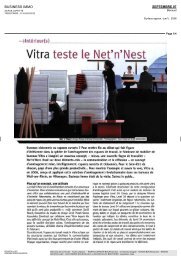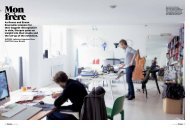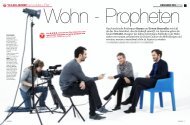pdf of vegetal - Ronan et Erwan Bouroullec
pdf of vegetal - Ronan et Erwan Bouroullec
pdf of vegetal - Ronan et Erwan Bouroullec
- No tags were found...
You also want an ePaper? Increase the reach of your titles
YUMPU automatically turns print PDFs into web optimized ePapers that Google loves.
Growing a Chair<strong>Ronan</strong> & <strong>Erwan</strong> <strong>Bouroullec</strong>The initial intuition was that <strong>of</strong> a chair which would sprout up likea plant. A <strong>veg<strong>et</strong>al</strong> chair, its branches gently curving to form the seatand back. It comes from this fascination we have for various types<strong>of</strong> old furniture, which is plant-inspired. Garden chairs <strong>of</strong> Englishorigin, structured in boughs <strong>of</strong> cast iron, for example; various itemsformed using real branches; or even those armchairs designedin the United States during the first half <strong>of</strong> the last century, usingbushes whose growth had been restricted until they took on theform <strong>of</strong> a chair. Objects which, in short, take us back to a timewhen forms were perhaps a little bulkier, less sleek or smooththan nowadays. There was therefore, from the outs<strong>et</strong>, a desire tocreate an original structure, based on a complex and narrative form<strong>of</strong> construction. Coupled with an inclination for highly advancedtechniques, such as plastic injection moulding, which opens theway to mass distribution.The initial designs show a chair that has the fluidity and uniformelegance <strong>of</strong> a plant: a great unity <strong>of</strong> form whilst at the same timebeing, in essence, untamed [fig. 4].They immediately appealed to Rolf Fehlbaum, but theircomplexity posed the question <strong>of</strong> industrial feasibility. This led to thestart <strong>of</strong> close collaboration with the team led by Egon Bräuning, head<strong>of</strong> the development department, which was to last almost four years.The main issue was to follow the realistic geom<strong>et</strong>ry <strong>of</strong> a chair, whilstat the same time using the principles <strong>of</strong> plant-like branching asa construction model [figs. 2, 3, 5]. What we felt was possible in orderto maintain the integrity <strong>of</strong> our proposed design was approachedin stages, whilst asking questions about its compatibility with themanufacturing process. Take Algues for example, developed byVitra in 2004 [fig. 1]. Its branching form was shown to be particularlysuited to the requirements <strong>of</strong> plastic injection moulding. Thisprocess consists <strong>of</strong> injecting the liquid material, under very highpressure, into a steel mould [fig. 26]. Just like the sap in a tree trunk,it has to circulate evenly inside all the branches <strong>of</strong> the mould,congeal and then solidify — and all in less than two minutes, at theend <strong>of</strong> which the piece is extracted. The major difficulty with thisprocess resides in the alchemy which has to take place b<strong>et</strong>ween thematerial, how quickly it moves, the fall in its temperature and itsm<strong>et</strong>hod <strong>of</strong> solidification. In other words, there is a certain number<strong>of</strong> uncertainties to grasp, given that the result must be perfectlyuniform.One <strong>of</strong> the important stages in the process consisted intransforming the branch sections, circular at the outs<strong>et</strong>, into aT-pr<strong>of</strong>ile [figs. 5, 12, 20, 21]. This solution gives b<strong>et</strong>ter structural qualitieswhilst at the same time me<strong>et</strong>ing the demands <strong>of</strong> injection fluidity.As luck would have it, it turned out that this solution reinforced theplant-like aspect <strong>of</strong> the whole piece.Throughout the entire duration <strong>of</strong> the project, the only way <strong>of</strong>conducting an in-depth study into industrial feasibility was torepresent the chair by means <strong>of</strong> our virtual modelling s<strong>of</strong>tware, thatis, an orthonormal digital script, which represents an obstacle tothe refined chaos <strong>of</strong> the organic. Resorting to this working m<strong>et</strong>hod,which consists <strong>of</strong> moving on from a drawing to three-dimensionalrepresentation, is unremitting. Here, we found a subterfuge: havingproduced drawings by hand on large she<strong>et</strong>s <strong>of</strong> paper on a ı:ı scale,these two-dimensional designs were projected onto the surface<strong>of</strong> a shell [figs. 11, 14, 15, 16]. On the seat and the back, this worked fairlywell, as the drawing <strong>of</strong> the branches does not move too much.Instead, there was serious distortion on the slope <strong>of</strong> the armrests.Like an anamorphosis. The distortion <strong>of</strong> the design, when appliedto the form in three dimensions, was a real surprise. The brancheshad to be redesigned. But the real difficulty lay in r<strong>et</strong>aining theirspontaneous aspect. The great ambiguity <strong>of</strong> this project wasto make the very sophisticated technique demanded by plasticinjection moulding cohabit with a necessary po<strong>et</strong>ry that can onlybe obtained through the sensitivity <strong>of</strong> drawing by hand [figs. 7, 8].Plastic chairs usually fall within two distinct groups: either theshell is fixed to the base, or the entire chair is moulded in a singlepiece. In the case <strong>of</strong> Veg<strong>et</strong>al, the solution adopted was different.For b<strong>et</strong>ter stability, the front legs are linked to the shell. In a certainway this causes them to be much more in line with the design <strong>of</strong>the chair. At the back, the legs are glued on. These are two separateparts. Then there was the issue <strong>of</strong> successfully incorporating themin a way that is fluid, but also structured. It was decided to branchout the circular sections <strong>of</strong> the legs to make them match up withthe T-pr<strong>of</strong>ile sections <strong>of</strong> the seat, the objective being to r<strong>et</strong>ain thesuggestion <strong>of</strong> an organic development [fig. 21].As well as the two- and three-dimensional design drawings,throughout the duration <strong>of</strong> the work process, models have enabledthe changes made to be visualized spatially. This part <strong>of</strong> thework was, on the one hand, carried out on very precise models,manufactured by Vitra [figs. 17, 18, 20, 21, 22, 23], and, on the other, on itemsmodelled by us, more sensitively [figs. 9, 10, 12, 13]. During the past year,when the process was speeding up, we were designing directly onto the models provided by Vitra, in order to perfect the position<strong>of</strong> each branch and the accuracy <strong>of</strong> its curve [fig. 19].Veg<strong>et</strong>al could not have existed without the technical sophistication<strong>of</strong> modern s<strong>of</strong>tware, in the same way that it could not have movedon from the finesse intrinsic to the stages <strong>of</strong> design drawing byhand. It is the close association <strong>of</strong> these two processes that has beenso special. The complexity <strong>of</strong> its form, which must be uniform as atree or a flower would be, has continuously forced us to r<strong>et</strong>hink thewhole thing in respect <strong>of</strong> each d<strong>et</strong>ail: one might say, this chair hasbeen redesigned a thousand times.Interview with Constance Rubini, January 2009.



